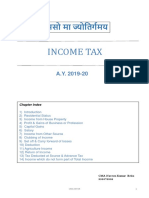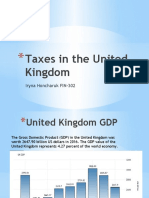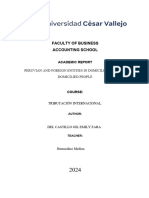Module I
Uploaded by
SAMRIDHI ADHIKARY 20113158Module I
Uploaded by
SAMRIDHI ADHIKARY 20113158Module – I
BASIC CONCEPTS
Name:
Roll No:
1.0 INTRODUCTION
Before one can embark on a study of the law of income-tax, it is absolutely vital to understand some of
the expressions found under the Income-tax Act, 1961. The purpose of this module is to enable the
students to comprehend basic expressions. Therefore, all such basic terms are explained and suitable
illustrations are provided to define their meaning and scope.
1.1 ASSESSMENT YEAR
“Assessment year” means the period starting from April 1 and ending on March 31 of the next year.
Example- Assessment year 2006-07 which will commence on April 1, 2006, will end on March 31,
2007.
Income of previous year of an assessee is taxed during the next following assessment year at the rates
prescribed by the relevant Finance Act [for tax rates, see below].
Check Your Progress
Activity A: Every financial year is an assessment year. Comment.
------------------------------------------------------------------------------------
---------------------------------------------------------------------------------------------------
---------------------------------------------------------------------------------------------------
---------------------------------------------------------------------------------------------------
1.2 PREVIOUS YEAR
Income earned in a year is taxable in the next year. The year in which income is earned is known as
previous year and the next year in which income is taxable is known as assessment year. In other
words, previous year is the financial year immediately preceding the assessment year.
Illustration 1.1 - For the assessment year 2006-07, the immediately preceding financial year (i.e., 2005-
06) is the previous year.
Income earned by an individual during the previous year 2005-06 is taxable in the immediately
following assessment year 2006-07 at the rates applicable for the assessment year 2006-07.
Similarly, income earned during the previous year 2006-07 by a company will be taxable in the
assessment year 2007-08 at the rates applicable for the assessment year 2007-08.
This rule is applicable in all cases subject to exceptions
Check Your Progress
Activity B: Previous year is a financial year immediately preceding the assessment year.
Comment.
---------------------------------------------------------------------------------------------------
---------------------------------------------------------------------------------------------------
---------------------------------------------------------------------------------------------------
School of Law, Christ University 1
1.3 WHEN INCOME OF PREVIOUS YEAR IS NOT TAXABLE IN THE IMMEDIATELY
FOLLOWING ASSESSMENT YEAR
The rule that the income of the previous year is taxable as the income of the immediately following
assessment year has certain exceptions. These are:
a. Income of non-residents from shipping;
b. Income of persons leaving India either permanently or for a long period of time;
c. Income of bodies formed for short duration;
d. Income of a person trying to alienate his assets with a view to avoiding payment of tax; and
e. Income of a discontinued business.
In these cases, income of a previous year may be taxed as the income of the assessment year
immediately proceeding the normal assessment year. These exceptions have been incorporated in order
to ensure smooth collection of income tax from the aforesaid taxpayers who may not be traceable if tax
assessment procedure is postponed till the commencement of the normal assessment.
1.4 A FINANCIAL YEAR HAS A DOUBLE ROLE TO PLAY - IT IS A PREVIOUS YEAR AS
WELL AS AN ASSESSMENT YEAR
On the basis of the aforesaid discussion, it can be said that a financial year plays a double role—it is a
previous year as well as an assessment year.
1.5 PERSON
The term “person” includes:
a. an individual;
b. a Hindu undivided family;
c. a company;
d. a firm;
e. an association of persons or a body of individuals, whether incorporated or not;
f. a local authority; and
g. every artificial juridical person not falling within any of the preceding categories.
These are seven categories of persons chargeable to tax under the Act. The aforesaid definition is
inclusive and not exhaustive. Therefore, any person, not falling in the above-mentioned seven
categories, may still fall in the four corners of the term “person” and accordingly may be liable to tax.
Check Your Progress
Activity C: Indicate whether the following statements are true or false
1. X is a partner of a firm. He is assessable as an “individual”.
2. Y is a managing director of A Ltd; Y is assessable as an “individual”.
---------------------------------------------------------------------------------------------------
---------------------------------------------------------------------------------------------------
---------------------------------------------------------------------------------------------------
---------------------------------------------------------------------------------------------------
School of Law, Christ University 2
1.6 ASSESSEE
“Assessee” means a person by whom income tax or any other sum of money is payable under the Act.
It includes every person in respect of whom any proceeding under the Act has been taken for the
assessment of his income or loss or the amount of refund due to him. It also includes a person who is
assessable in respect of income or loss of another person or who is deemed to be an assessee, or
an assessee in default under any provision of the Act.
1.7 HOW TO CHARGE TAX ON INCOME
To know the procedure for charging tax on income, one should be familiar with the following:
1 Annual tax - Income-tax is an annual tax on income.
2 Tax rate of assessment year - Income of previous year is chargeable to tax in the next following
assessment year at the tax rates applicable for the assessment year. This rule is, however, subject to
some exceptions ;
3 Rates fixed by Finance Act - Tax rates are fixed by the annual Finance Act and not by the Income-tax
Act. For instance, the Finance Act, 2006, fixes tax rates for the assessment year 2006-07.
4 Tax on person - Tax is charged on every person ;
5 Tax on total income - Tax is levied on the “total income” of every assessee computed in accordance
with the provisions of the Act.
1.8 MEANING OF INCOME
The definition of the term “income” in section 2(24) is inclusive and not exhaustive. Therefore, the
term “income” not only includes those things that are included in section 2(24) but also includes those
things that the term signifies according to its general and natural meaning.
1.9GROSS TOTAL INCOME
As per section 14, the income of a person is computed under the following five heads:
1. Salaries.
2. Income from house property.
3. Profits and gains of business or profession.
4. Capital gains.
5. Income from other sources.
The aggregate income under these heads is termed as “gross total income”. In other words, gross total
income means total income computed in accordance with the provisions of the Act before making any
deduction under sections 80C to 80U.
1.10 INCOME TAX RATES
Income Tax Rates for Assessment Year 2009-10 (F Y 2008-09)
Individuals & HUFs
AOPs & BOIs
Co-operative Society
Firm
Local Authority
School of Law, Christ University 3
Domestic Company
Other Company
A. Individuals and HUFs
In case of individual (other than II and III below) and HUF:-
Income Level / Slab Income Tax Rate
Where the total income does not exceed
i. NIL
Rs.1,50,000/-.
Where the total income exceeds Rs.1,50,000/- 10% of amount by which the total income ex-
ii.
but does not exceed Rs.3,00,000/-. ceeds Rs. 1,50,000/-
Where the total income exceeds Rs.3,00,000/- Rs. 15,000/- + 20% of the amount by which the
iii.
but does not exceed Rs.5,00,000/-. total income exceeds Rs.3,00,000/-.
Rs. 55,000/- + 30% of the amount by which the
iv. Where the total income exceeds Rs.5,00,000/-.
total income exceeds Rs.5,00,000/-.
II. In case of individual being a woman resident in India and below the age of 65 years at any time dur-
ing the previous year:-
Income Level / Slab Income Tax Rate
Where the total income does not exceed
i. NIL
Rs.1,80,000/-.
Where total income exceeds Rs.1,80,000/- but10% of the amount by which the total income
ii.
does not exceed Rs.3,00,000/-. exceeds Rs.1,80,000/-.
Where the total income exceeds Rs.3,00,000/-Rs. 12,000- + 20% of the amount by which the
iii.
but does not exceed Rs.5,00,000/-. total income exceeds Rs.3,00,000/-.
Rs.52,000/- + 30% of the amount by which the
iv. Where the total income exceeds Rs.5,00,000/-
total income exceeds Rs.5,00,000/-.
III. In case of an individual resident who is of the age of 65 years or more at any time during the previ-
ous year:-
Income Level / Slab Income Tax Rate
Where the total income does not exceed
i. NIL
Rs.2,25,000/-.
Where the total income exceeds Rs.2,25,000/-10% of the amount by which the total income
ii.
but does not exceed Rs.3,00,000/- exceeds Rs.2,25,000/-.
Where the total income exceeds Rs.3,00,000/-Rs.7,500/- + 20% of the amount by which the
iii.
but does not exceed Rs.5,00,000/- total income exceeds Rs.3,00,000/-.
Rs.47,500/- + 30% of the amount by which the
iv. Where the total income exceeds Rs.5,00,000/-
total income exceeds Rs.5,00,000/-.
Further, the amount of income tax as computed in accordance with above rates, and after being reduced
by the amount of tax rebate shall be increased by a surcharge at the rate of 10% of such income tax,
provided that the total income exceeds Rs. 10 lacs. Thus, in case of individuals/HUFs no surcharge
shall be payable if the total income is below Rs.10 lacs.
The tax and surcharge, if any, are to be further enhanced by education cess levied @ 3% from A.
Y. 2008-09 onwards.
School of Law, Christ University 4
B. Association of Persons (AOP) and Body of Individuals (BOI)
i. Income-tax:
Income Level / Slab Income Tax Rate
Where the total income does not exceed
i. NIL
Rs.1,50,000/-.
Where the total income exceeds Rs.1,50,000/- 10% of amount by which the total income ex-
ii.
but does not exceed Rs.3,00,000/-. ceeds Rs. 1,50,000/-
Where the total income exceeds Rs.3,00,000/- Rs. 15,000/- + 20% of the amount by which the
iii.
but does not exceed Rs.5,00,000/-. total income exceeds Rs.3,00,000/-.
Rs. 55,000/- + 30% of the amount by which the
iv. Where the total income exceeds Rs.5,00,000/-.
total income exceeds Rs.5,00,000/-.
ii. Surcharge: The amount of income tax as computed in accordance with above rates, and after being
reduced by the amount of tax rebate shall be increased by a surcharge at the rate of 10% of such in-
come tax, provided that the total income exceeds Rs. 10 lacs.
iii. Education Cess: 3% of the total of Income-tax and Surcharge.
C. Co-operative Society
i. Income-tax:
Income Level / Slab Income Tax Rate
Where the total income does not exceed
i. 10% of the income.
Rs. 10,000/-.
Where the total income exceeds Rs.10,000/- but Rs. 1,000/- + 20% of income in excess of Rs.
ii.
does not exceed Rs.20,000/-. 10,000/-.
Rs. 3.000/- + 30% of the amount by which total
iii. Where the total income exceeds Rs.20,000/-
income exceeds Rs.20,000/-.
ii. Surcharge: Nil
iii. Education Cess: 3% of the Income-tax.
D. Firm
i. Income-tax: 30% of total income.
ii. Surcharge: The amount of income tax as computed in accordance with above rates, and after being
reduced by the amount of tax rebate shall be increased by a surcharge at the rate of 10% of such in-
come tax, provided that the total income exceeds Rs. 1 crore.
iii. Education Cess: 3% of the total of Income-tax and Surcharge.
E. Local Authority
i. Income-tax: 30% of total income.
ii. Surcharge: Nil
iii. Education Cess: 3% of Income-tax.
School of Law, Christ University 5
F. Domestic Company
i. Income-tax: 30% of total income.
ii. Surcharge: The amount of income tax as computed in accordance with above rates, and after being
reduced by the amount of tax rebate shall be increased by a surcharge at the rate of 10% of such in-
come tax, provided that the total income exceeds Rs. 1 crore.
iii. Education Cess: 3% of the total of Income-tax and Surcharge.
G. Company other than a Domestic Company
i. Income-tax:
• @ 50% of on so much of the total income as consist of (a) royalties received from Government
or an Indian concern in pursuance of an agreement made by it with the Government or the Indi-
an concern after the 31st day of March, 1961 but before the 1st day of April, 1976; or (b) fees
for rendering technical services received from Government or an Indian concern in pursuance
of an agreement made by it with the Government or the Indian concern after the 29th day of
February, 1964 but before the 1st day of April, 1976, and where such agreement has, in either
case, been approved by the Central Government;
• @ 40% of the balance
ii. Surcharge: The amount of income tax as computed in accordance with above rates, and after being
reduced by the amount of tax rebate shall be increased by a surcharge at the rate of 2.5% of such in-
come tax, provided that the total income exceeds Rs. 1 crore.
iii. Education Cess: 3% of the total of Income-tax and Surcharge.
Activity D: Find out the tax liability in the following cases:
1. Mrs. X (age: 66 years) for the assessment year 2009-10 if her income is Rs. 11, 20,000.
2. X (age: 28 years) for the assessment year 2009- 10 if his income is Rs. 5, 56,000.
3. Y (date of birth: April 2, 1940) for the assessment year 2009-10 is his income is Rs. 8, 86,000.
4. Z (date of birth: January 31, 1952) for the assessment year 2009-10 if his income is Rs. 15, 10,000.
---------------------------------------------------------------------------------------------------
---------------------------------------------------------------------------------------------------
---------------------------------------------------------------------------------------------------
---------------------------------------------------------------------------------------------------
------------------------------------------------------------------------------------------------
1.11 SELF ASSESSMENT EXERCISES
1. Income of a previous year is chargeable tax in the immediately following assessment year. Is there
any exception to this rule? Discuss.
School of Law, Christ University 6
2. Define the term “person”.
3. How would you calculate income-tax for the assessment year 2009-10 in the case of different
assesses?
4. Explain how surcharge on income-tax and education cess to applicable for the
assessment year 2009-107?
5. X starts his business on April 26, 2005. Determine the previous year to the assessment year 2006-07?
6. Every financial year is a previous year as well as an assessment year. Discuss.
School of Law, Christ University 7
You might also like
- HEI P U 0543 - SelfLearning - 20210723105858No ratings yetHEI P U 0543 - SelfLearning - 202107231058584 pages
- HEI P U 0543 - SelfLearning - 20210723105858No ratings yetHEI P U 0543 - SelfLearning - 202107231058584 pages
- Definition of Assessee' - Section 2 (7) of Income TaxNo ratings yetDefinition of Assessee' - Section 2 (7) of Income Tax7 pages
- Basic Concepts in Income Tax-Ay 2024-2025No ratings yetBasic Concepts in Income Tax-Ay 2024-202517 pages
- Income Tax Law & Practice-Lesson - 1 To 12No ratings yetIncome Tax Law & Practice-Lesson - 1 To 12250 pages
- Introduction and Basic Concepts of Income TAXNo ratings yetIntroduction and Basic Concepts of Income TAX60 pages
- Explanatory Notes - Income Tax-I - DR - Kamaraj50% (2)Explanatory Notes - Income Tax-I - DR - Kamaraj100 pages
- Prof. K. S. Jaiswal: Department of CommerceNo ratings yetProf. K. S. Jaiswal: Department of Commerce16 pages
- Basic Concepts of Income Tax: DR Vijay Kumar Khurana Professor, DPC-IM, DelhiNo ratings yetBasic Concepts of Income Tax: DR Vijay Kumar Khurana Professor, DPC-IM, Delhi16 pages
- Notes Of Chapter 1 - Income Tax (Basic Concepts)No ratings yetNotes Of Chapter 1 - Income Tax (Basic Concepts)32 pages
- Basic Concepts & Definations Income Tax ActNo ratings yetBasic Concepts & Definations Income Tax Act6 pages
- PGDFM Taxation Syllabus Notes PDF FormatNo ratings yetPGDFM Taxation Syllabus Notes PDF Format231 pages
- Ashok Kumar Kalra vs Surendra AgnihotriNo ratings yetAshok Kumar Kalra vs Surendra Agnihotri25 pages
- 1A Historical Background of Income Tax LawNo ratings yet1A Historical Background of Income Tax Law53 pages
- LAW_OF_TAXATION(LAW951)-1725886882026.htmlNo ratings yetLAW_OF_TAXATION(LAW951)-1725886882026.html19 pages
- Taxation (TX-UK) FA 2020 - Ebook - RepairedNo ratings yetTaxation (TX-UK) FA 2020 - Ebook - Repaired756 pages
- Taxes in The United Kingdom: Iryna Honcharuk FIN-302No ratings yetTaxes in The United Kingdom: Iryna Honcharuk FIN-30226 pages
- Principles of Taxation Study Manual 2013 PDFNo ratings yetPrinciples of Taxation Study Manual 2013 PDF316 pages
- Using These Slides: 1 © Margaret Bray LSENo ratings yetUsing These Slides: 1 © Margaret Bray LSE107 pages
- ESOL Close Reading About The 2024 Budget Article 1No ratings yetESOL Close Reading About The 2024 Budget Article 15 pages
- Local Government Finance in Bangladesh 2No ratings yetLocal Government Finance in Bangladesh 224 pages
- November 2021 (v2) QP - Paper 1 CAIE Economics IGCSENo ratings yetNovember 2021 (v2) QP - Paper 1 CAIE Economics IGCSE12 pages
- ATX UK J25-M26 syllabus and study guideNo ratings yetATX UK J25-M26 syllabus and study guide24 pages
- Advanced Taxation - United Kingdom (ATX-UK) : Syllabus and Study GuideNo ratings yetAdvanced Taxation - United Kingdom (ATX-UK) : Syllabus and Study Guide25 pages
- Definition of Assessee' - Section 2 (7) of Income TaxDefinition of Assessee' - Section 2 (7) of Income Tax
- Basic Concepts of Income Tax: DR Vijay Kumar Khurana Professor, DPC-IM, DelhiBasic Concepts of Income Tax: DR Vijay Kumar Khurana Professor, DPC-IM, Delhi
- 1040 Exam Prep - Module I: The Form 1040 FormulaFrom Everand1040 Exam Prep - Module I: The Form 1040 Formula
- 1040 Exam Prep Module III: Items Excluded from Gross IncomeFrom Everand1040 Exam Prep Module III: Items Excluded from Gross Income
- Taxes in The United Kingdom: Iryna Honcharuk FIN-302Taxes in The United Kingdom: Iryna Honcharuk FIN-302
- ESOL Close Reading About The 2024 Budget Article 1ESOL Close Reading About The 2024 Budget Article 1
- November 2021 (v2) QP - Paper 1 CAIE Economics IGCSENovember 2021 (v2) QP - Paper 1 CAIE Economics IGCSE
- Advanced Taxation - United Kingdom (ATX-UK) : Syllabus and Study GuideAdvanced Taxation - United Kingdom (ATX-UK) : Syllabus and Study Guide








































































































